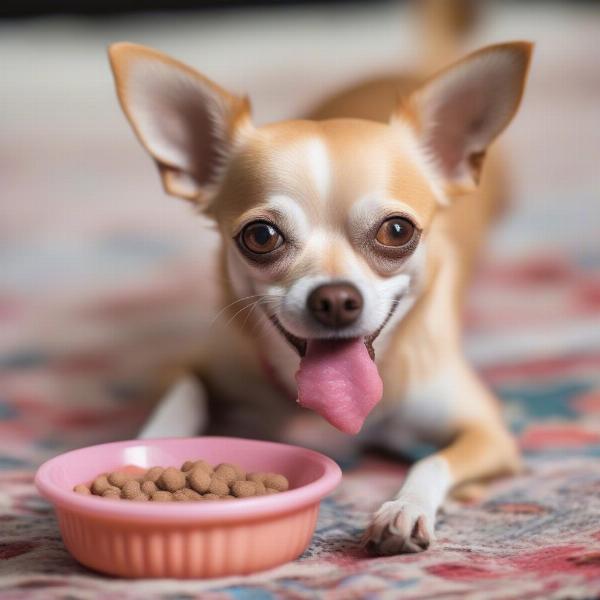Losing teeth is a common issue for senior dogs, but it can also occur in younger dogs due to injury or illness. It can be a challenge to figure out the right diet for a toothless dog, as their nutritional needs remain the same, but their ability to chew significantly changes. This article will explore the best options for feeding your dog with no teeth, ensuring they receive the necessary nutrients for a happy and healthy life.
Understanding the Dietary Needs of a Toothless Dog
Even without teeth, your dog still needs a balanced diet with plenty of protein, healthy fats, carbohydrates, vitamins, and minerals. The key is to adapt the food’s texture and consistency to make it easily consumable. Consider your dog’s breed, age, size, activity level, and any underlying health conditions when determining their specific dietary requirements.
 Dog without teeth eating soft food
Dog without teeth eating soft food
Choosing the Right Food for Your Toothless Dog
There are several excellent options for feeding a dog with no teeth. The best choice depends on your dog’s individual preferences and any existing health issues.
Softened Kibble
Many commercial dog foods can be softened with warm water, broth, or even milk (if tolerated). This is often the easiest and most affordable option, especially if your dog already enjoys a particular brand of kibble. Soak the kibble for about 15-20 minutes, or until it reaches a mushy consistency.
Canned Food
Canned dog food is another convenient option, as it’s already soft and palatable. Look for high-quality canned food with a good balance of nutrients and a smooth texture. Be mindful of the calorie content, as canned food can be higher in calories than dry kibble.
Homemade Food
Preparing homemade dog food allows you to control the ingredients and ensure your dog receives a balanced diet. You can create soft, easily digestible meals by pureeing cooked meats, vegetables, and grains. Consult with your veterinarian or a veterinary nutritionist to create a recipe that meets your dog’s specific nutritional needs.
Specially Formulated Diets
Some pet food manufacturers offer specially formulated diets for senior dogs or dogs with dental issues. These diets often have a softer texture and smaller kibble size, making them easier to chew and digest.
What about Raw Diets?
While some dog owners prefer raw diets, they can be challenging for toothless dogs due to the difficulty in chewing and the potential risk of bacterial contamination. If you are considering a raw diet for your toothless dog, consult with your veterinarian to ensure it’s safe and nutritionally complete.
Tips for Feeding a Toothless Dog
- Small, Frequent Meals: Offer smaller, more frequent meals throughout the day to avoid overloading your dog’s digestive system.
- Elevated Food Bowls: Using elevated food bowls can make it easier for your dog to eat comfortably, especially if they have mobility issues.
- Monitor Weight: Regularly monitor your dog’s weight to ensure they are maintaining a healthy weight. Adjust portion sizes as needed.
- Dental Hygiene: Even without teeth, regular gum cleaning is essential to prevent infection.
What if My Dog Won’t Eat?
If your toothless dog refuses to eat, consult with your veterinarian. They can help determine if there are any underlying medical reasons for their loss of appetite.
Conclusion
Feeding a dog with no teeth requires careful consideration and adaptation. By choosing the right food and implementing these tips, you can ensure your dog receives the necessary nutrients to thrive. Always consult your veterinarian if you have any concerns about your dog’s diet or health. Remember, a toothless dog can still enjoy a happy and healthy life with the right care.
FAQ
- Can I feed my dog baby food? While some baby foods might be safe occasionally, they are not formulated for dogs and may not provide balanced nutrition.
- What should I do if my dog is choking on its food? Seek immediate veterinary attention.
- Can I add supplements to my dog’s food? Always consult with your veterinarian before adding any supplements.
- How often should I clean my dog’s gums? Ideally, daily. Your veterinarian can demonstrate proper gum cleaning techniques.
- What are signs my dog is having trouble eating? Drooling excessively, dropping food, chewing slowly, or avoiding food altogether.
- Is it expensive to feed a dog with no teeth? Not necessarily. Softened kibble and canned food are affordable options.
- My dog seems to be losing weight despite eating. What should I do? Consult your veterinarian to rule out any underlying health issues.
Related Articles
ILM Dog is your global go-to for expert dog care and breed information. We provide practical and reliable advice on dog nutrition, health, training, grooming, and much more. Whether you’re a seasoned dog owner or just starting your journey, ILM Dog has the resources you need to ensure your furry friend lives a happy and healthy life. For personalized guidance and support, reach out to our team of experts at [email protected] or call us at +44 20-3965-8624. Visit us at ILM Dog for more information.